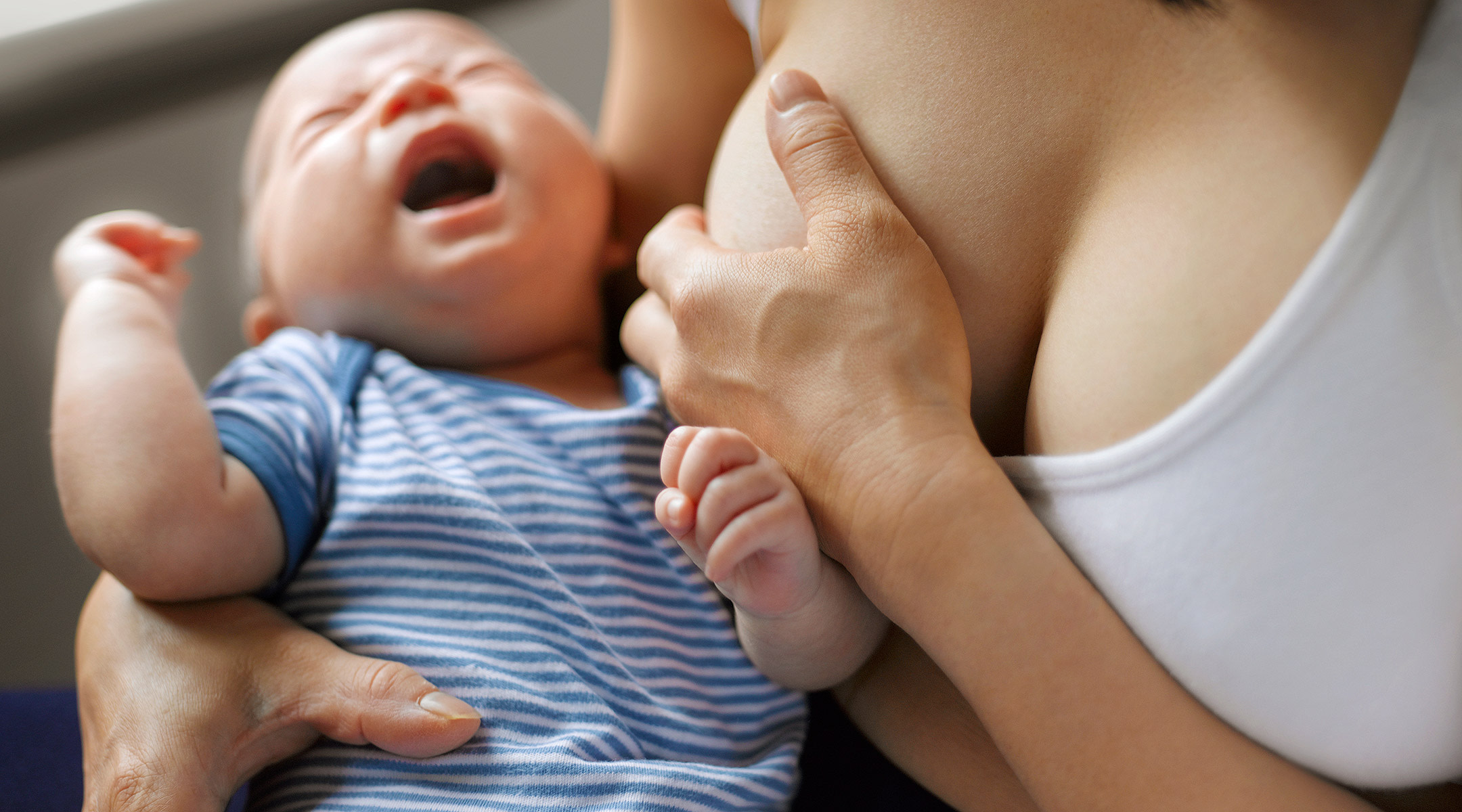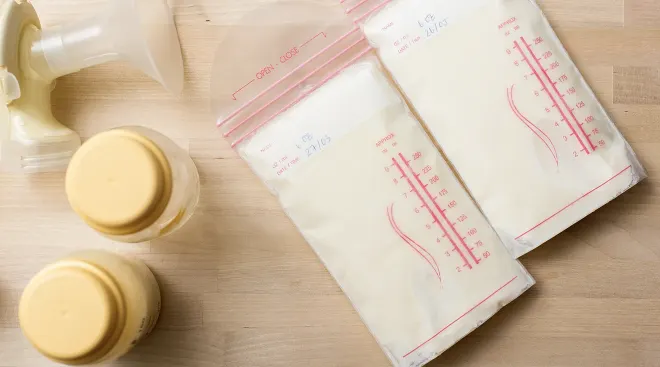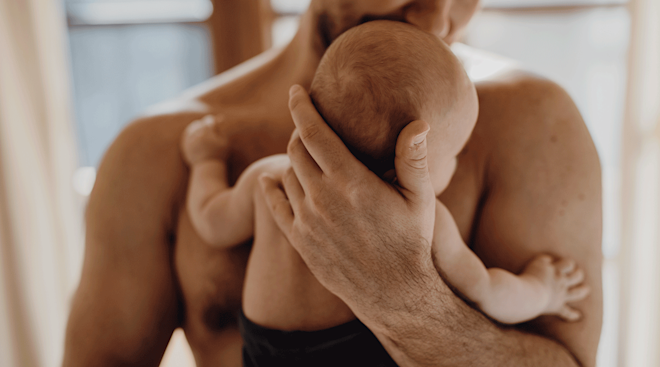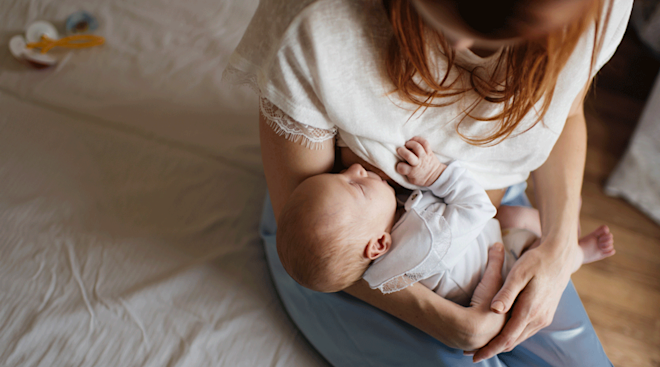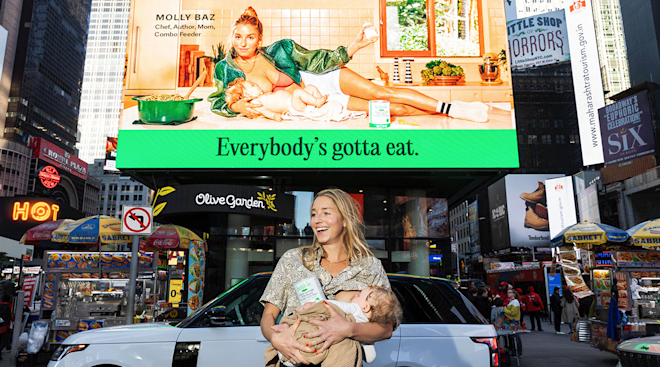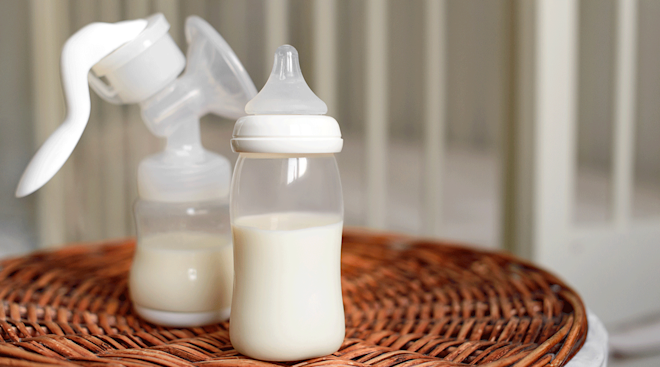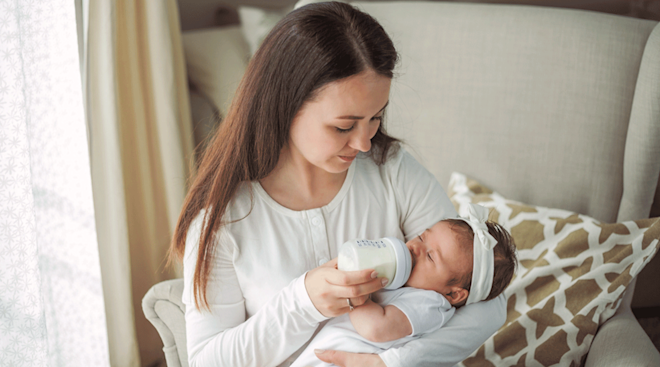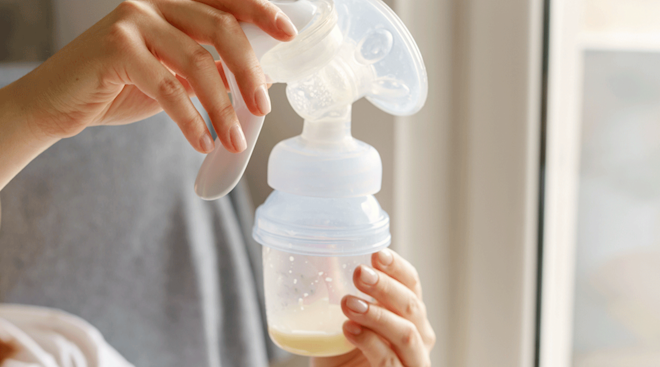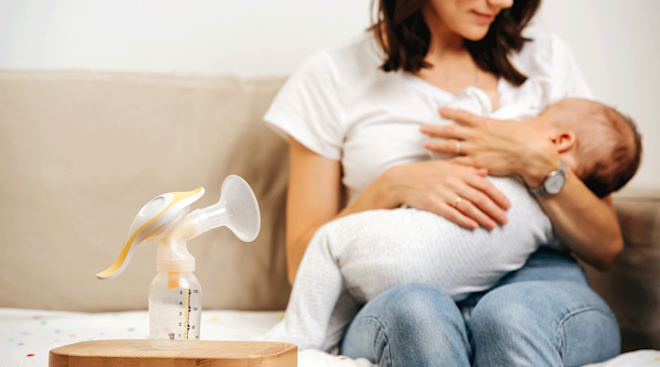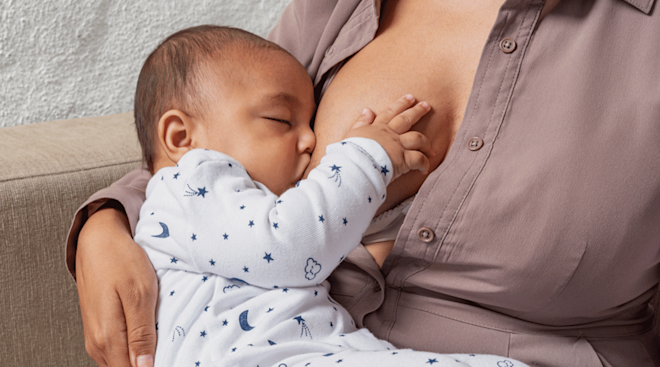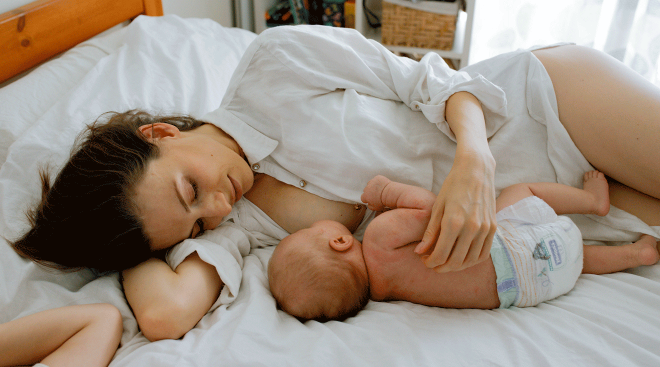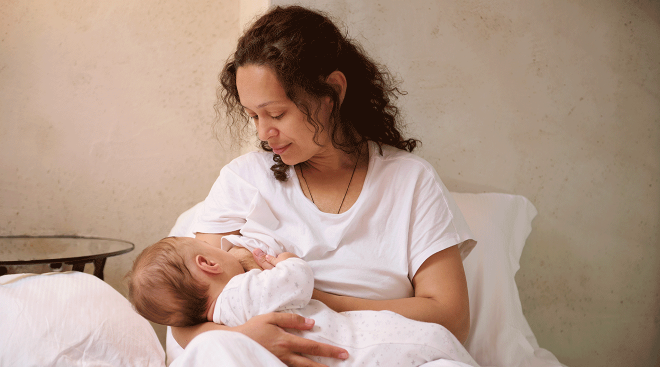Here’s How to Stop Mastitis From Making Breastfeeding Unbearable
After nursing her first daughter for nearly six months with virtually no problems, Meagan E. suddenly found herself in a lot of pain. “When I first experienced symptoms, it was primarily tender, hot, swollen spots in my breast,” she says. “It seemed to happen at times when my daughter’s nursing needs or habits changed and my body was trying to adjust. I was still producing milk, but she wasn’t eating as much, and I wasn’t pumping as much at work.”
Not knowing the cause, Meagan Googled her symptoms, trying recommended remedies such as hot compresses, gentle massage and pumping to relieve the pressure. But when her symptoms became more severe, almost flu-like—a fever higher than 101℉, chills, body aches and fatigue—she turned to her doctor. The diagnosis? Mastitis, and she was given an antibiotic to clear it up.
“Mastitis merely means inflammation of the breast,” says Kecia Gaither, MD, a board-certified ob-gyn and maternal fetal medicine specialist in New York City. You don’t have to be breastfeeding to get it, though that’s usually the case, and it can either come with an infection or not. Either way, the breast is red, swollen and sore. Dawn A., a mom who suffered from mastitis, describes it as “The worst pain ever—literally worse than my 46-hour, all-natural, drug-free childbirth!”
So how do you get mastitis? In breastfeeding women, there are typically two primary mastitis causes:
1. A clogged milk duct. When milk isn’t removed frequently or efficiently enough from the breast, the channel through which milk flows literally becomes so overwhelmed that milk builds up and is unable to flow out of the breast, resulting in what feels like tender lumps,” says Andrea Syms-Brown, an International Board Certified Lactation Consultant (IBCLC). “If this isn’t cleared within a few hours, the breast may then develop the classic mastitis symptoms: red blotches, an elevated temperature (above 100 degrees), chills and a general achy feeling.”
2. Infection. Mastitis can also occur when bacteria creeps into the milk duct. “A crack on the nipple from a poor latch or poor pumping can allow them to get inside the breast and create infection,” says Leigh Anne O’Connor, IBCLC, who offers lactation consulting services and resources at LeighAnneOConnor.com. “As with a clogged milk duct, this can also lead to an inflammatory response.” Common bacterial culprits are Staphylococcus aureus, Staphylococcus albus, Escherichia coli and Streptococcus aureus. The foreign invader then causes the redness and pain associated with inflammation.
Studies show that somewhere between 10 percent to one third of women may experience mastitis, with most symptoms occurring in the first three months of nursing, according to a mastitis report published by the World Health Organization (WHO). Some moms are more vulnerable than others, depending on a few factors:
• Age. Women who are 21 to 35 years old are more prone to mastitis, with the highest risk being women ages 30 to 34.
• History. Studies have shown 40 to 54 percent of women who previously had mastitis are more apt to suffer another attack. Experts think this could be the result of improper breastfeeding.
• Work. If you’re employed full-time outside your home, your chances for mastitis may increase. That’s because longer intervals in between pumping, as well as not enough time to void the breast completely of milk, can lead to milk stasis.
• Trauma. Any injury caused to the breast tissue that negatively affects glands and duct performance could increase a woman’s odds of mastitis.
Though it most commonly occurs in the first three months after giving birth, mastitis symptoms can erupt even when you’ve been nursing for longer than that. Keep an eye out for the following signs of mastitis:
- Tender, swollen breasts
- The presence of one or more lumps in the breast
- Breasts that are warm or hot to the touch
- Breast pain or burning either during or while not breastfeeding
- Red skin, sometimes in a wedge-shaped pattern
- Flu-like symptoms, such as chills or fatigue
- Fever of 101℉ (38.3℃) or greater
“In general, mastitis without infection occurs over a widespread area, whereas a clogged milk duct is usually localized,” Gaither says. “Both can present with redness, pain and swelling, but symptoms in mastitis are generally more severe. Fever and flu-like symptoms are synonymous with an infectious process.”
If you notice nipple damage or painful lumps, seek help immediately. “Time is always of the essence,” Syms-Brown says. After all, when the inflammation in the breast isn’t treated, you can end up with an abscess, which typically requires surgical drainage.
How to treat mastitis with professional help
Often, the solution is as simple as getting in touch with an International Board Certified Lactation Consultant—aka, a veritable fairy godmother who will offer breastfeeding strategies to ease the swelling and pain. (Find one near you by checking out ILCA.org. If you’re feeling flu-like symptoms or if the pain persists for longer than 24 hours, call your doctor. He might suggest treating it in the short-term with an over-the-counter analgesic, such as ibuprofen. He may also prescribe an antibiotic. Mastitis symptoms should improve within three days, but you’ll need to take it for the entire recommended course (typically 10 to 14 days).
Home remedies for mastitis
To soothe the pain in the meantime, try the following home remedies for mastitis. The moms we interviewed swear by them.
• Nursing. As excruciating as it may be, breastfeeding through the pain is key to mastitis treatment. Baby’s suckling can help remove any clog while also draining the breast of residual milk. (See “Tips for Breastfeeding With Mastitis” for details.)
• Moist heat. Before nursing, improve circulation to the breast area by using warm wet compresses or soaking in a warm bath or shower.
• Garlic. “Garlic is a food with natural anti-inflammatory properties,” Gaither says. “The garlic can be ingested in various modes—raw, gel capsules, cooked in foods.” The general rule of thumb is to limit your garlic consumption to about four cloves a day, but talk to your doctor if you’re eager to eat more. Just know that when you eat tons of garlic, its essence exudes from the pores and breath—good for you, bad for anyone in your immediate area.
• Cabbage leaves. You can thank Amanda Peet for their popularity with pregnant women: In 2015, she wore them in her bra. But using cabbage leaves for mastitis isn’t as crazy as it sounds. “Cabbage, like garlic, also contains anti-inflammatory chemicals,” Gaither says. “I generally tell my patients to place a cabbage in the refrigerator. When it’s cold, crush some of the larger leaves with your hands and then bind them to the breasts. It tends to supply relief for at least four to five hours, and decreases the swelling.” It worked for Elizabeth D—“like a charm,” she says.
Breastfeeding through the pain is not only an effective mastitis treatment, it also helps keep your milk supply up. Fortunately, in most cases, the milk is okay for baby to drink. “A healthy baby whose immune system isn’t compromised should be fine if you have and are being treated for mastitis,” Syms-Brown says. Most medications are safe to take while nursing, and if you remind your provider that you’re still breastfeeding, she’ll prescribe the appropriate treatment. While waiting for your mastitis treatment to work its magic, try these expert nursing strategies:
• Sore breast first. Baby is hungriest at the start of your nursing session, so always begin with the painful breast. Massage, pump or hand-express your breast first to help milk flow more easily for baby.
• Check your latch. “Pay attention to getting an effective latch, letting baby determine the feeding time instead of the clock,” Syms-Brown says. “Baby should be actively drinking for most of the time you’re nursing.” If he’s not, then you might need to correct the latch so that suckling is more productive. Work with an IBCLC to establish proper positioning of baby while breastfeeding.
• Breastfeed often. Milk production is an ongoing process, so it needs to be removed to decrease the pressure on your breast. Aim to breastfeed every two hours or whenever baby is hungry, and let him nurse as long as necessary. When breastfeeding is not an option, pump your breast milk just as often, making sure to eliminate the supply in the breast.
• Change positions. Switch up your nursing position to help empty your breast completely of breast milk. Experiment: A cradle hold may work for one breast while a side-lying position may work better for the other.
• Check your breasts. “Always feel your breasts before and after nursing. The milk should be completely drained, and the breasts, softer or lighter afterward,” Syms-Brown says. (If not, then pump or hand-express the remainder.) “Be alert to painful or tender areas that feel the same after one to three feedings. Again, reach out for help if tender areas stay tender and/or become reddened.”
Moms who’ve been there have made it clear—you do not want mastitis! The best way to treat it is to avoid it in the first place. Protect your breasts with these mastitis prevention tips.
• Rest. As with a cold or the flu, the more rundown your body is, the harder the time it has fighting off what ails you. So give it the downtime it deserves. Reduce stress and anxiety whenever possible, and get as much sleep as a newborn baby and your equally tired partner allow. Try napping while baby is catching some ZZZs, and listen to calming music or guided meditations while you breastfeed.
• Drink. Staying hydrated with water will improve circulation while also helping to keep milk flowing.
• Nurse. We’ve said it before, and we’ll say it again: Nursing is a must! If the milk has somewhere to go, it won’t lead to a blockage or infection.
• Lighten up. Tight clothing, restrictive purses or bag straps, ill-fitting bras and sleeping on your chest can create pressure on your breasts that can lead to nursing pain and mastitis.
• Eat healthy. Boost your immune system with fresh whole foods rich in vitamin C (citrus fruits, bell peppers), vitamin A (sweet potatoes, broccoli, carrots, kale), probiotics (Greek yogurt), vitamin E (almonds, spinach, avocado) and vitamin B-6 (chicken, turkey, sunflower seeds).
• Wash up. Clean your hands with soap and water before and after breastfeeding, which can help to eliminate possible sources of bacteria.
• Ask for help. Syms-Brown recommends taking a prenatal breastfeeding class in your area or online, or check in with a lactation consultant or coach. Reading about mastitis prevention tips is helpful, but getting one-on-one assistance can mean information tailored just for you and baby’s needs.
While mastitis is typically associated with new moms, special types of mastitis can affect all women, and symptoms can vary. See your doctor if you suspect the following:
• Granulomatous mastitis. While mastitis—as well as an inflamed clogged milk duct—can cause you to feel a lump in your breast, this very rare type of mastitis can affect women whether or not they’re breastfeeding. Its origins are unknown, and it’s benign, but it’s also often clinically misdiagnosed via ultrasound as breast cancer. “Granulomatous mastitis presents with pain, a breast mass and tissue distortion. The patient may also have skin thickening and nipple retraction, just like a breast malignancy,” Gaither says. A study of a tissue sample biopsy is typically needed to make an accurate diagnosis.
• Periductal Mastitis. Periductal mastitis may be caused by bacteria (but doesn’t have an entirely clear cause), tends to occur more in smokers and is not specifically related to breastfeeding. Similar to the other types of mastitis, it manifests as inflammation of or around the milk ducts, causing breast tenderness, inverted nipples and nipple discharge.
Published July 2017
Please note: The Bump and the materials and information it contains are not intended to, and do not constitute, medical or other health advice or diagnosis and should not be used as such. You should always consult with a qualified physician or health professional about your specific circumstances.
Navigate forward to interact with the calendar and select a date. Press the question mark key to get the keyboard shortcuts for changing dates.

































